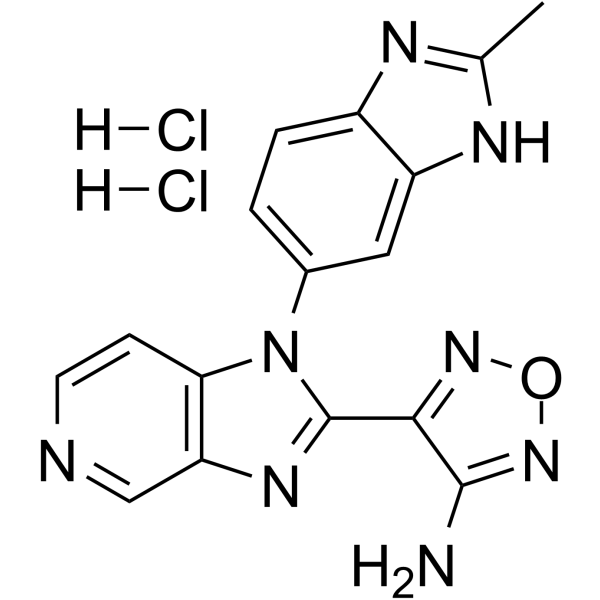Physicochemical Properties
| Molecular Formula | C16H14CL2N8O |
| Molecular Weight | 405.2414 |
| Exact Mass | 404.066 |
| CAS # | 2241300-51-4 |
| Related CAS # | AS2863619 free base;2241300-50-3 |
| PubChem CID | 139600293 |
| Appearance | White to off-white solid powder |
| Hydrogen Bond Donor Count | 4 |
| Hydrogen Bond Acceptor Count | 7 |
| Rotatable Bond Count | 2 |
| Heavy Atom Count | 27 |
| Complexity | 495 |
| Defined Atom Stereocenter Count | 0 |
| SMILES | O1N=C(C(C2=NC3C=NC=CC=3N2C2C=CC3=C(C=2)NC(C)=N3)=N1)N.Cl.Cl |
| InChi Key | LHUAALWRORLTCJ-UHFFFAOYSA-N |
| InChi Code | InChI=1S/C16H12N8O.2ClH/c1-8-19-10-3-2-9(6-11(10)20-8)24-13-4-5-18-7-12(13)21-16(24)14-15(17)23-25-22-14;;/h2-7H,1H3,(H2,17,23)(H,19,20);2*1H |
| Chemical Name | 4-[1-(2-methyl-3H-benzimidazol-5-yl)imidazo[4,5-c]pyridin-2-yl]-1,2,5-oxadiazol-3-amine;dihydrochloride |
| HS Tariff Code | 2934.99.9001 |
| Storage |
Powder-20°C 3 years 4°C 2 years In solvent -80°C 6 months -20°C 1 month Note: Please store this product in a sealed and protected environment, avoid exposure to moisture. |
| Shipping Condition | Room temperature (This product is stable at ambient temperature for a few days during ordinary shipping and time spent in Customs) |
Biological Activity
| Targets | CDK8 0.61 nM (IC50) CDK19 4.28 nM (IC50) GSK3α 76.67 nM (IC50) GSK3β 63.06 nM (IC50) STAT5 |
| ln Vitro | Treatment with AS2863619 (1 μM; 22 hours; mouse CD4+ T cells) reduces serine phosphorylation of STAT5b's PSP motif to around 40% while increasing tyrosine phosphorylation in the C-terminal domain to approximately 160% of control-treated samples[1]. |
| ln Vivo | After sensitization to 2,4-dinitrofluorobenzene (DNFB), mice treated with AS2863619 (30 mg/kg; oral administration; daily; for 2 weeks) showed reduced levels of secondary response, milder infiltration of inflammatory cells into the skin, and lower ratios of interferon-γ+ (IFN-γ+) cells in a skin contact hypersensitivity model when compared to vehicle-treated control mice. AS2863619-induced suppression is eliminated by treg depletion prior to the subsequent reaction being elicited. Mice treated with AS2863619 and sensitized to DNFB exhibit a particular increase in KLRG1+ Foxp3+ T cells[1]. |
| Cell Assay |
Western Blot Analysis[1] Cell Types: Mouse CD4+ T cells Tested Concentrations: 1 μM Incubation Duration: 22 hrs (hours) Experimental Results: Suppressed serine phosphorylation of the PSP motif of STAT5b to ~40% while enhancing tyrosine phosphorylation in the C-terminal domain to ~160% of control-treated samples. |
| Animal Protocol |
Animal/Disease Models: Mice with DNFB-induced contact skin hypersensitivity[1] Doses: 30 mg/kg Route of Administration: Oral administration; daily; for 2 weeks Experimental Results: The degree of the secondary response, with milder infiltration of inflammatory cells into the skin and diminished ratios of interferon-γ+ (IFN-γ+) cells. |
| References |
[1]. Conversion of antigen-specific effector/memory T cells into Foxp3-expressing Treg cells by inhibition of CDK8/19. Sci Immunol. 2019 Oct 25;4(40). pii: eaaw2707. |
Solubility Data
| Solubility (In Vitro) |
DMSO : 250 mg/mL (616.92 mM) H2O : ≥ 100 mg/mL (246.77 mM) |
| Solubility (In Vivo) |
Solubility in Formulation 1: ≥ 2.62 mg/mL (6.47 mM) (saturation unknown) in 5% DMSO + 40% PEG300 + 5% Tween80 + 50% Saline (add these co-solvents sequentially from left to right, and one by one), clear solution. Preparation of saline: Dissolve 0.9 g of sodium chloride in 100 mL ddH₂ O to obtain a clear solution. Solubility in Formulation 2: ≥ 2.62 mg/mL (6.47 mM) (saturation unknown) in 5% DMSO + 95% (20% SBE-β-CD in Saline) (add these co-solvents sequentially from left to right, and one by one), clear solution. Preparation of 20% SBE-β-CD in Saline (4°C,1 week): Dissolve 2 g SBE-β-CD in 10 mL saline to obtain a clear solution. Solubility in Formulation 3: ≥ 2.25 mg/mL (5.55 mM) (saturation unknown) in 10% DMSO + 40% PEG300 + 5% Tween80 + 45% Saline (add these co-solvents sequentially from left to right, and one by one), clear solution. For example, if 1 mL of working solution is to be prepared, you can add 100 μL of 22.5 mg/mL clear DMSO stock solution to 400 μL PEG300 and mix evenly; then add 50 μL Tween-80 to the above solution and mix evenly; then add 450 μL normal saline to adjust the volume to 1 mL. Preparation of saline: Dissolve 0.9 g of sodium chloride in 100 mL ddH₂ O to obtain a clear solution. Solubility in Formulation 4: ≥ 2.25 mg/mL (5.55 mM) (saturation unknown) in 10% DMSO + 90% (20% SBE-β-CD in Saline) (add these co-solvents sequentially from left to right, and one by one), clear solution. For example, if 1 mL of working solution is to be prepared, you can add 100 μL of 22.5 mg/mL clear DMSO stock solution to 900 μL of 20% SBE-β-CD physiological saline solution and mix evenly. Preparation of 20% SBE-β-CD in Saline (4°C,1 week): Dissolve 2 g SBE-β-CD in 10 mL saline to obtain a clear solution. Solubility in Formulation 5: ≥ 2.25 mg/mL (5.55 mM) (saturation unknown) in 10% DMSO + 90% Corn Oil (add these co-solvents sequentially from left to right, and one by one), clear solution. For example, if 1 mL of working solution is to be prepared, you can add 100 μL of 22.5 mg/mL clear DMSO stock solution to 900 μL of corn oil and mix evenly. (Please use freshly prepared in vivo formulations for optimal results.) |
| Preparing Stock Solutions | 1 mg | 5 mg | 10 mg | |
| 1 mM | 2.4677 mL | 12.3384 mL | 24.6767 mL | |
| 5 mM | 0.4935 mL | 2.4677 mL | 4.9353 mL | |
| 10 mM | 0.2468 mL | 1.2338 mL | 2.4677 mL |
